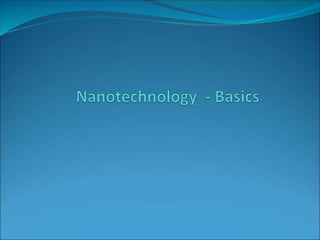
nanotechnology Basics for beginners.ppt
- 2. Presentation Layout 1-Introduction 1.1- What is Nanotechnology? 1.1.1- Why nanoscale? 1.1.2- What is nanomaterial? 1.1.3- Nanomaterials’ characteristics 1.2- When Nanotechnology started 1.3- Approaches of Nanotechnology 1.3.1- Bottom-up or top-down? 2- Applications of Nanotechnology
- 3. 1.1- What is Nanotechnology? The design, characterization, and application of structures, devices, and systems by controlled manipulation of size and shape of materials at the nanometer scale (atomic, molecular, and macromolecular scale) , To produce materials with at least one novel/superior characteristic or property.
- 4. Why Nanoscale? A nanometer (nm) is one thousand millionth of a meter. People are interested in the nanoscale because at this scale physical and chemical properties of materials differ significantly from those at a larger scale.
- 6. 1.1.2- What is nanomaterial? Is defined as any material that has unique or novel properties, due to the nanoscale ( nano metre- scale) structuring. These are formed by incorporation or structuring of nanoparticles. They are subdivided into nanocrystals, nanopowders, and nanotubes: A sequence of nanoscale of C60 atoms arranged in a long thin cylindrical structure.
- 7. 1.1.2- What is nanomaterial? carbon nanotubes
- 8. 1.1.2- What is nanomaterial? Noble metal nanocrystals with cyclic penta-twinned structures
- 9. 1.1.2- What is nanomaterial? Naonpowder
- 10. 1.1.2- What is nanomaterial? Nanotubes are extremely strong mechanically and very pure conductors of electric current. Applications of the nanotube include resistors, capacitors, inductors, diodes and transistors. ),.
- 11. 1.1.2- What is nanomaterial? Nanomaterials are interesting because at the small scale, materials have fundamentally different properties than at the bulk due to increased surface area to volume ratios.
- 12. 1.1.2- What is nanomaterial? Increased interaction and reactvity is one of the by products of materials that are nanoscale, which means potentially using less of the material or that even on the nanoscale the properties are so utterly different from that of the bulk scale.
- 13. 1.1.2- Nanomaterials’ Characteristics Most of them are novel, why? One definition of novel materials is: (new forms of existing materials with characteristics that differ significantly from familiar or naturally-occurring forms.) Nanomaterials can have one, two or three dimensions in the nanoscale:
- 14. example Category of nanomaterials layers, multi-layers, thin films, platelets and surface coatings. They have been developed and used for decades, particularly in the electronics industry. One-dimensional nanomaterials nanowires, nanofibres made from a variety of elements other than carbon, nanotubes and, a subset of this group, carbon nanotubes. Two-dimensional nanomaterials are known as nanoparticles and include precipitates, colloids and quantum dots (tiny particles of semiconductor materials), and Nanocrystalline materials Three-dimensional nanomaterials 1.1.2- Nanomaterials’ Characteristics
- 15. 1.2- When Nanotechnology started In some senses, nanoscience and nanotechnologies are not new. Chemists have been making polymers, which are large molecules made up of nanoscale subunits, for many decades and nanotechnologies have been used to create the tiny features on computer chips for the past 20 years.
- 16. 1.2- When Nanotechnology started However, advances in the tools that now allow atoms and molecules to be examined and probed with great precision have enabled the expansion and development of nanoscience and nanotechnologies.
- 17. 1.3- Approaches of Nanotechnology (growth methods ): 1.3.1- Bottom-up or top-down? Bottom-up approaches seek to have smaller components built up into more complex assemblies, while top-down approaches seek to create nanoscale devices by using larger, externally controlled ones to direct their assembly. The top-down approach often uses the traditional workshop or micro-fabrication methods where externally controlled tools are used to cut, mill, and shape materials into the desired shape and order.
- 18. 1.3.1- Bottom-up or top-down? Micropatterning techniques, such as photolithography and inkjet printing belong to this category. Bottom-up approaches, in contrast, use the chemical properties of single molecules to cause single-molecule components to (a) self-organize or self-assemble into some useful conformation, or (b) rely on positional assembly.
- 19. 1.3.1- Bottom-up or top-down?
- 20. 2- Applications of Nanotechnology: 2.1 General Applications Examples Application Diagnostics, Drug delivery, Tissue engineering, Cryonics Medicine Memory storage, Novel semiconductor devices, Novel optoelectronic devices, Displays, Quantum computers Information and communication Aerospace, Catalysis, Catalysis, Construction Vehicle manufacturers Heavy Industry Foods, Household, Optics, Textiles, Cosmetics, Sports Consumer goods Environment
- 21. 2.2- Environmental Applications Check http://www.nanowerk.com/products/product.php?id=160 for more details Examples Application Photocatalyst consisting of silica Nanosprings coated with a combination of titanium dioxide Carbon capture Pollutants sensors that able to detect lower limits with low cost Sensors Heavy metal decontaminant removes heavy metals such as lead, cadmium, nickel, zinc, copper, manganese and cobalt in a neutral pH environment without using any form of sulphur . Remediation (decontamination, oil spill management) Veolia Water Solutions & Technologies' ceramic membrane modules, utilizing the CeraMem technology platform, can be supplied with a variety of inorganic microfiltration and ultrafiltration membranes. Wastewater treatment Heat distribution e.g. ceramic-like materials that provide sufficient reliability and durability of the entire structure Energy Drinking water purification
- 22. Thank You for Your Attention